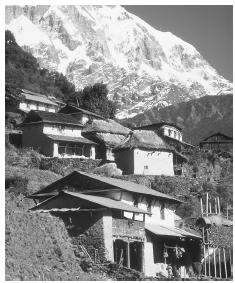Nepal is one of the richest countries in the world in terms of bio- diversity due to its unique geographical position and altitudinal variation. The elevation of the country ranges from 60m above sea le
 vel to the highest point in the earth, Mt Everest at 8,848m all within a distance of 150km resulting in to climatic condition form sub- tropical to Arctic. From the highest mountain in the world to dense forests that are home to a rich and wide variety of wildlife and fauna, within this spectacular geography is also one of the richest cultural landscapes anywhere. Nepal is also home to a rich cultural heritage and it offers an astonishing diversity of sightseeing attractions and adventure opportunities found nowhere else on earth. Moreover, you can join in the numerous annual festivals that are celebrated throughout the year in traditional style highlighting enduring customs and beliefs. A visit to Nepal is not only about discovering a new destination but also building new friendships and lasting memories from the Nepal Himalaya.
vel to the highest point in the earth, Mt Everest at 8,848m all within a distance of 150km resulting in to climatic condition form sub- tropical to Arctic. From the highest mountain in the world to dense forests that are home to a rich and wide variety of wildlife and fauna, within this spectacular geography is also one of the richest cultural landscapes anywhere. Nepal is also home to a rich cultural heritage and it offers an astonishing diversity of sightseeing attractions and adventure opportunities found nowhere else on earth. Moreover, you can join in the numerous annual festivals that are celebrated throughout the year in traditional style highlighting enduring customs and beliefs. A visit to Nepal is not only about discovering a new destination but also building new friendships and lasting memories from the Nepal Himalaya. Nepal's acronym of Never Ending Peace And Love, does well to characterize this nation of good natured and accommodating people; a land of majestic Himalayan scenery comprising eight of the world's ten highest mountains, including Mt Everest. Situated between India and Tibet, the democracy of Nepal is filled with many different ethnic groups, customs and traditions reflected in a wonderfully diverse geography.
Spread across these varied altitudes are communities of colorful cultures and people (many untouched by modern development), animated cities and towns, and far-flung mountain villages. Life here revolves around an intricate intermingling of ancient Hindu and Buddhist religious rituals. Numerous festivals are celebrated throughout the year colored by a diversity of religious and tribal traditions. The capital of Kathmandu brings an assortment of these different societies together into a vibrant collection of brilliant sights and exotic smells, with modern shops co-existing with street sellers, while pyramidal Buddhist temples, holy Sadhus of the Hindu faith and medieval palace squares fill the urban landscape.
Nepal has many attractions, but the essence of the country is its smiling, friendly people with their heartfelt palm-pressed greetings and together with its inspiring Nepal Himalaya’s scenery, Nepal is a place where one visit is usually not enough to satisfy the captivated traveler.
Nepal is one of the richest country in the world, in the terms of bio-diversity due to its unique geographical position and altitude variation. The elevation of the country ranges from 60m above sea level to the highest point on earth, Mt. Everest at 8848 m, all within a distance of 150 km resulting into climatic conditions from Sub-tropical to Arctic.
Location: | Situated between Tibetan Autonomous Region of the People’s Republic of China in the north and India in the South, East and West. |
Area: | 147,181 Sq. Km. |
Longitude: | 80° 4’ and 88°12’ East. |
Capital: | Kathmandu |
Population: | 23.1 million |
People: | Nepal has more than 101 ethnic groups and 92 spoken languages |
Language: | Nepali is the official language of Nepal. However, English is understood and spoken by majority of people in Kathmandu valley and other major cities. |
Political-System: | Multiparty Democracy |
Time: | 5 hours 45 minutes ahead of GMT and 15 minutes ahead of Indian Standard Time |
National Bird: | Impean Pheasant (Danfe) |
National Flower: | Rhododendron- Arboreum (Lali Gurans) |
Religion: | Main religion in Nepal is Hinduism. However Buddhism, Islam and Christian religions are followed by some people. All religions even in minority have co-existed amicably in Nepal for ages. |
Vegetation: | Most outstanding bio-diversity in the world, ranging from sub-tropical Rain-forests to Alpine deserts |
Electricity: | 220 Volts AC - 50 Cycles |
Weather: | Climate ranges from Tropical in the lowlands to arctic higher altitudes |
Monsoon: | June to August. However, most of the northern belts of Trans-Himalayan Zones are in the rain-shadow which provides rain free trekking. |
Topography: | From the worlds deepest gorge ‘Kaligandaki to Mt. Everest, the highest point on earth |



